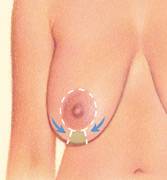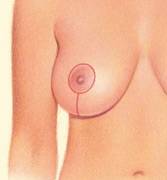Over the years, factors such as pregnancy, nursing, ageing and the force of gravity take their toll on a woman's breasts. As the skin loses its elasticity, the breasts often lose their shape and firmness and begin to sag. |
What is breast lift? |
Breast lift, or mastopexy, is a surgical procedure to raise and reshape the sagging breasts. Mastopexy can also reduce the size of the areola, the darker skin surrounding the nipple. If your breasts are small or have lost volume--for example, after pregnancy--breast implants inserted in conjunction with mastopexy can increase both their firmness and their size. |
How it is done? |
To correct the sagging of breasts, the excess breast skin is removed and the nipple and areola complex is shifted to a higher position. And further the breast tissue is fixed to the chest wall. This will in turn tighten; firm and re contour the breast for desired projection. The areola is also reduced to proportionate shape and size. |
Breast lift surgery can vary in the design of the incisions. Size and shape of your breasts, size of your areolas, and extent of the sagging are some of the factors that will be taken in account while planning for the surgery. |
  |
Anesthesia |
General anesthesia or local anesthesia. |
Hospital stay |
It is a day care surgery. |
Operation time |
2 to 3 hours. |
Recovery |
Most women return to their usual activities in one week. However, you must not lift anything for the first two weeks and do no heavy lifting for the first four weeks. |
Scar |
For major lift the scar is around the areola and vertically going down from areola for further few inches.
In case of minor degree of breast sagging there will be a small scar around the areola that very often fades into natural border.
|
Implant + Breast lift
|
Incase of loss of breast volume, breast is made full with the placement of implant along with breast lift surgery. |
Risk |
When a mastopexy is performed by a qualified plastic surgeon, complications are infrequent and usually minor. Still, individuals vary greatly in their anatomy, their physical reactions, and their healing abilities, and the outcome is never completely predictable.
The most common complications following mastopexy include the following:
|
This is a collection of serum in small pockets beneath the skin. Generally, the seroma will spontaneously resorb. Occasionally, needle aspiration is necessary. |
Infection |
Infection following mastopexy is uncommon. |
Hematoma |
Any type of surgery may result in bleeding in the operated area. If the accumulation of blood is small, it may be allowed to absorb by itself or aspiration may be indicated as with a seroma. However, if it is large, formal drainage may be necessary. |
Breast asymmetry |
It must be emphasized that no pair of breasts ever starts out exactly the same and there will always be some differences after mastopexy surgery. The goal is to minimize these differences. |
Contour deformities |
These can occur in the breast tissue and result in rippling, divots, and sunken nipples. Sometimes these become less apparent with time. |
Inability to breast feed
|
Interference with or inability to breastfeed may be possible in case of major breast lift surgery. |
Partial or complete loss of nipple sensation
This is generally a temporary change, but for a small number of patients may be permanent.
|
Recurrent breast sagging
|
Recurrent breast sagging may be possible especially with significant weight changes.
|
Delayed healing
|
Death (necrosis) of tissue resulting in delayed healing: When blood circulation is inadequate to bring sufficient oxygen to the tissues, some of the tissue (skin, fat or in rare cases even the nipple) furthest away from the blood supply may be lost. Skin necrosis is uncommon in non-smokers.
|
Scars
|
Any time the skin is opened a scar of some kind results. This may be a good scar (fine white line) or a conspicuous one. Each individual’s healing is different. The surgeon has no influence on the actual formation of a scar. Factors that can influence the quality of healing include smoking, obesity, infection and bleeding.
|
| |